Field Camera Woods
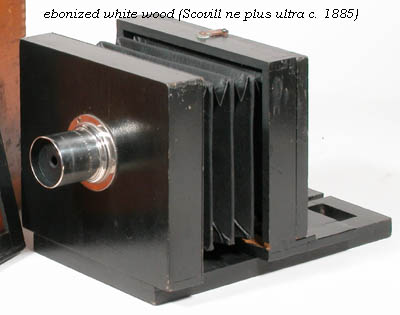 For
inexpensive cameras, the wood used is usually referred to as white wood,
that is, any one of several softwoods having little or no graining and
are easy to work and shape, e.g., basswood (Linden), or poplar.
Because there is little grain, such wood was often ebonized, that is,
painted black.
For
inexpensive cameras, the wood used is usually referred to as white wood,
that is, any one of several softwoods having little or no graining and
are easy to work and shape, e.g., basswood (Linden), or poplar.
Because there is little grain, such wood was often ebonized, that is,
painted black.
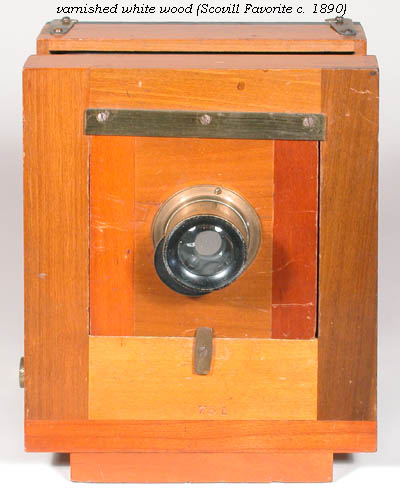
Regardless of the limited beauty of white wood, it was also sometimes
varnished.
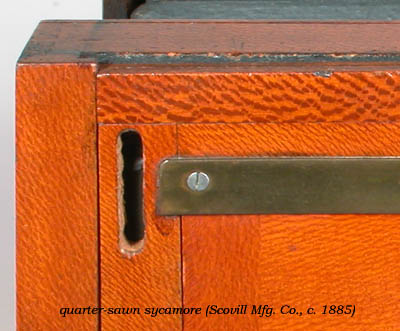 Scovill
used another type of wood for several inexpensive models (e.g.,
the New York, and probably the Dry Plate Outfit).
This wood has a distinctive flecked appearance that comes from
quarter-sawn sycamore, which is also known as American lacewood.
Scovill
used another type of wood for several inexpensive models (e.g.,
the New York, and probably the Dry Plate Outfit).
This wood has a distinctive flecked appearance that comes from
quarter-sawn sycamore, which is also known as American lacewood.
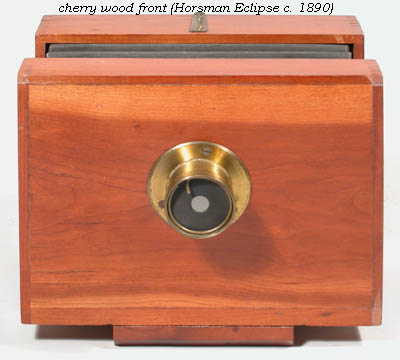 For
middle or high-end cameras, hardwoods were utilized. Camera-making
was very similar to cabinet-making (fine furniture making), so the same
techniques and woods that can be found in furniture can also be found in
view cameras of the period. In the late 1800's, the classic
hardwoods of American furniture were cherry and mahogany. Cherry
(or perhaps other fruitwood) was used for bases or rails, even on
cameras that were mainly mahogany, because of its toughness.
However, some relatively inexpensive cameras used cherry throughout, and
could still advertise that they were made of hardwood. The
Rochester Optical Company New Model was made of all cherry
throughout its long period of production, although more highly figured
cherry seems to have been used on early variations than on later ones.
For
middle or high-end cameras, hardwoods were utilized. Camera-making
was very similar to cabinet-making (fine furniture making), so the same
techniques and woods that can be found in furniture can also be found in
view cameras of the period. In the late 1800's, the classic
hardwoods of American furniture were cherry and mahogany. Cherry
(or perhaps other fruitwood) was used for bases or rails, even on
cameras that were mainly mahogany, because of its toughness.
However, some relatively inexpensive cameras used cherry throughout, and
could still advertise that they were made of hardwood. The
Rochester Optical Company New Model was made of all cherry
throughout its long period of production, although more highly figured
cherry seems to have been used on early variations than on later ones.
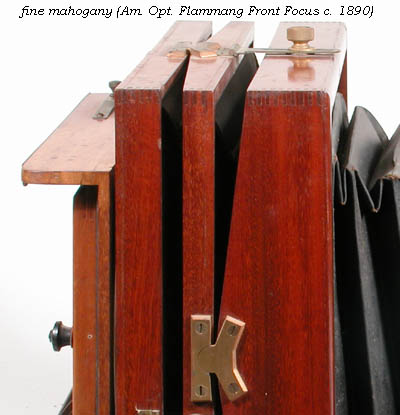 The
cabinetmaker's choice of wood was mahogany, though, which has an
interesting grain and color, and is easily worked to close tolerances.
It is brittle, however - so much so that when a mahogany camera part is
broken, the pieces can often be put back together without the repair
being visible. Mahogany is a commercial term for any of dozens of
tropical trees that have generally red wood and close grain. As
older trees were cut or new markets were exploited, the species'
available to the camera maker changed. Also, some old growth trees
having fancy grain would have been more expensive than faster growing
trees having relatively plain grain. As a result, there is a wide
variety of appearance of mahogany. Generally, older cameras and
more expensive cameras show the fancy grain, where newer and less
expensive cameras have less interesting wood.
The
cabinetmaker's choice of wood was mahogany, though, which has an
interesting grain and color, and is easily worked to close tolerances.
It is brittle, however - so much so that when a mahogany camera part is
broken, the pieces can often be put back together without the repair
being visible. Mahogany is a commercial term for any of dozens of
tropical trees that have generally red wood and close grain. As
older trees were cut or new markets were exploited, the species'
available to the camera maker changed. Also, some old growth trees
having fancy grain would have been more expensive than faster growing
trees having relatively plain grain. As a result, there is a wide
variety of appearance of mahogany. Generally, older cameras and
more expensive cameras show the fancy grain, where newer and less
expensive cameras have less interesting wood.
Mahogany is not as suitable for the hard use that assaults camera tracks, so often, a mahogany box will be combined with cherry tracks, then finished with stained varnish or lacquer to be all of one color.
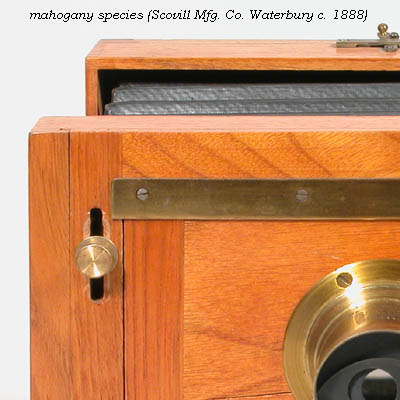 The
mahogany found on cameras of the American Optical Co. usually appear to
be fine grained if not highly figured (i.e., from slow-growing
trees whose wood is expensive) and very finely filled and finished,
whereas the mahogany found on cameras marked Scovill Mfg. Co. is usually
open and coarsely grained, even though Scovill owned American Optical.
An extreme example is the wood on Waterbury cameras, which,
strictly speaking, is probably a species of mahogany, yet is very porous
and hardly even reddish. When combined with the varnish finish
rather than the more expensive French polish, the choice of wood
consistently expresses the Waterbury's position as a
median-priced model.
The
mahogany found on cameras of the American Optical Co. usually appear to
be fine grained if not highly figured (i.e., from slow-growing
trees whose wood is expensive) and very finely filled and finished,
whereas the mahogany found on cameras marked Scovill Mfg. Co. is usually
open and coarsely grained, even though Scovill owned American Optical.
An extreme example is the wood on Waterbury cameras, which,
strictly speaking, is probably a species of mahogany, yet is very porous
and hardly even reddish. When combined with the varnish finish
rather than the more expensive French polish, the choice of wood
consistently expresses the Waterbury's position as a
median-priced model.
 E.
& H. T. Anthony advertised one model, the Victor, as being
constructed either of mahogany or of highly-figured Circassion
walnut, a synonym for English walnut. In that walnut can
appear very similar to a darker, fine-grained mahogany, it is not
certain that the example given is, in fact, walnut, but it is more
highly grained than other, lighter-in-color, examples of the Victor.
E.
& H. T. Anthony advertised one model, the Victor, as being
constructed either of mahogany or of highly-figured Circassion
walnut, a synonym for English walnut. In that walnut can
appear very similar to a darker, fine-grained mahogany, it is not
certain that the example given is, in fact, walnut, but it is more
highly grained than other, lighter-in-color, examples of the Victor.
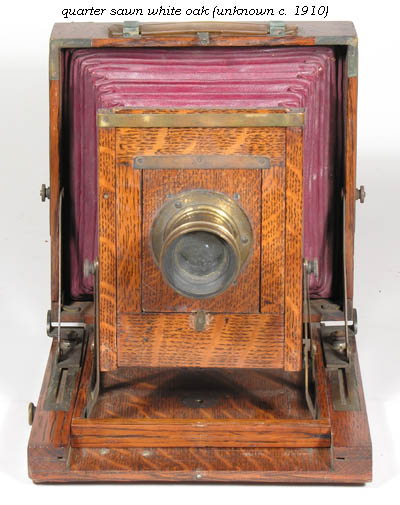 The
Craftsman Movement c. 1910 produced an interest in furniture
manufactured from fumed quarter-sawn white oak, a process that produces
a medium brown color having contrasting light flecks throughout.
Since camera-makers were originally furniture-makers it is perhaps
surprising that there aren't more cameras constructed of oak, but then,
by 1910, camera factories had been specializing for decades.
Quarter-sawn oak cameras are known, as the example shows, even if their
manufacturers are not.
The
Craftsman Movement c. 1910 produced an interest in furniture
manufactured from fumed quarter-sawn white oak, a process that produces
a medium brown color having contrasting light flecks throughout.
Since camera-makers were originally furniture-makers it is perhaps
surprising that there aren't more cameras constructed of oak, but then,
by 1910, camera factories had been specializing for decades.
Quarter-sawn oak cameras are known, as the example shows, even if their
manufacturers are not.
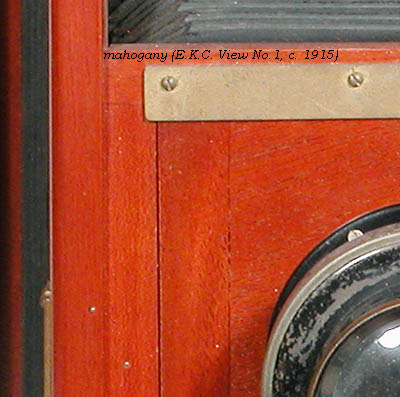 By
about 1910, whether by choice or whether by the exhaustion of more
figured wood, the mahogany in cameras is rather bland in appearance.
And in 1921, Kodak introduced the 2d (d as in dark finish), whose
walnut stain effectively obscured the grain. About the only
worse thing to happen to a camera's appearance is the Ansco battleship
gray paint of the mid-20th century.
By
about 1910, whether by choice or whether by the exhaustion of more
figured wood, the mahogany in cameras is rather bland in appearance.
And in 1921, Kodak introduced the 2d (d as in dark finish), whose
walnut stain effectively obscured the grain. About the only
worse thing to happen to a camera's appearance is the Ansco battleship
gray paint of the mid-20th century.
